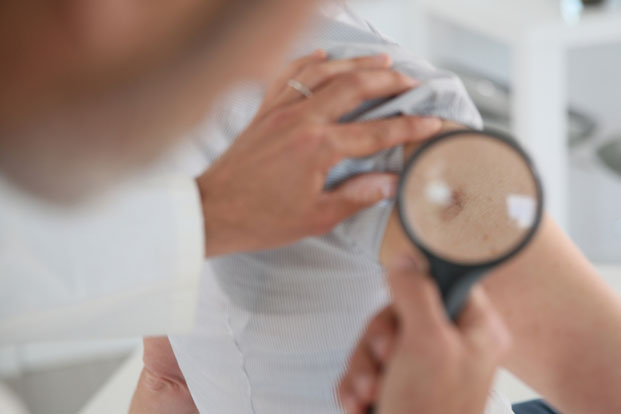Got a suspicious-looking mole? How about adult-onset acne? You just may want to make an appointment with a dermatologist.
Dermatologists are the go-to sources for skin, hair and nail health. According to the American Academy of Dermatology, these specialists both diagnose and treat over 3,000 different issues like acne, skin cancer, psoriasis, eczema and even nail infections. Plus, dermatologists can help you battle the frustrating signs of aging.
To get the most out of your dermatologist appointment, you need to know what to expect. While an appointment with a dermatologist won’t be as “hands-on” as a visit to the gynecologist, it will involve skin exposure.
The Skin Cancer Foundation says that this will include an examination of the skin on all parts of your body. This means that you need to be prepared in ways that you wouldn’t expect.
Prepping for the Appointment
Part of exposing your body means uncovering those beautifully painted digits ahead of time. “Remove all nail polish from your fingernails and toenails,” Dr. Elizabeth Tanzi, co-director of laser surgery at the Washington Institute of Dermatologic Laser Surgery in Washington, D.C., and assistant professor in the Department of Dermatology at Johns Hopkins Hospital Center, tells the Skin Cancer Foundation. “We need to look at your nails and nail beds, since skin cancers can form there.”
Know that your dermatologist will put you through the ringer. In this process, he or she will search for moles, growths and lesions. Specifically, your doctor will look for various signs of abnormalities like changes in existing growths, new growths, bleeding and itching. Plus, he or she will want your feedback about what you have observed on your body. Tanzi notes, “you’re the person who has the best chance of noticing small changes.”
This is why you will want to perform a self-exam on your skin before your appointment. Observe your skin with the intent of finding moles, skin tags and dark spots (like freckles). Be thorough in this process, searching high and low. Look for changes to moles or freckles that you already knew existed.
For example, if a mole has gotten bigger or changed color, you’ll want to tell your doctor this. And remember that a simple freckle may not be a freckle at all, so make note of everything that you see. Write this information down and make a list of all of your concerns — starting with the biggest concern and working your way down to the smallest one. This will help prioritize what needs to be discussed.
Further, prepare your medical history ahead of time. Write down all health issues that you’ve experienced so that you don’t have to recall them on the day of your appointment. And write down all medications that you’re taking, including prescription meds, over the counter meds and even supplements. After all, these meds could interact with meds that your dermatologist prescribes. And make note of any family history of skin cancer and how much time you’ve spent in the sun as well as places that burns have occurred.
What to Do on Appointment Day
On the day of your appointment, you’ll want to make the best possible use of your time. Exams can be pretty short. In fact, Tanzi says that an annual skin exam on a healthy person with no atypical moles may take just 10 minutes. But numerous moles equate to more time. So the more you have on your body, the more time the doctor will need to spend examining them.
At your doctor’s appointment, don’t be shy. You’ll probably be asked to wear a cloth gown so that your doctor can observe your skin in all areas. This is a good thing because you want doctors to see everything to catch concerning issues early.
Know that you may experience some new things that you haven’t experienced at other types of physicals. According to Health Central, your full body exam may include an exam of the areas between your fingers and toes, genitals, and even a quick peek at your scalp and hairline.
Plus, your moles may need to “say cheese” because pictures may be taken of them. And notes will be recorded regarding freckles and moles that you have. This helps doctors to know what to look at when you come back for your next exam.
If something seems abnormal, Health Central says that a bright light could be used to illuminate the area. This gives your dermatologist the best possible view of moles and other skin growths.
A biopsy may be performed if an area looks concerning, but don’t be scared — it won’t hurt. Affected areas will be numbed so that you don’t feel pain. Then a portion of the area will be removed and later analyzed in a lab. You probably won’t get results that day, but they will be delivered at a later time. And if something abnormal has been found, a follow-up appointment will be scheduled.
Self-Care Between Appointments
Finally, before you leave your appointment, you may want to ask your dermatologist to teach you how to examine your own skin. Tanzi says that this should include how to examine the scalp, toes and even the bottoms of your feet. There’s good reason for doing this, so don’t skip this step.
“Because patients are often uninformed about what they need to look for, they can be prey to misconceptions about what is a cause for concern,” Tanzi says. “For example, a lot of patients ask me if their raised moles are dangerous Additionally, I’m often asked if a mole should be removed because it itches. For instance, a patient will have a mole that gets chafed and irritated by clothing. In general, irritation does not lead to skin cancer. If it’s truly a benign nevus (mole) or lesion, then irritation from clothing over long periods of time is not going make it cancerous.”

Leave a Reply